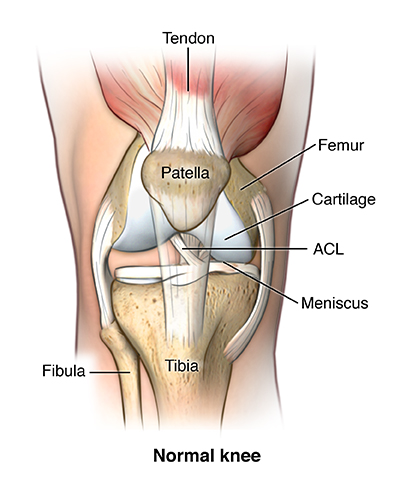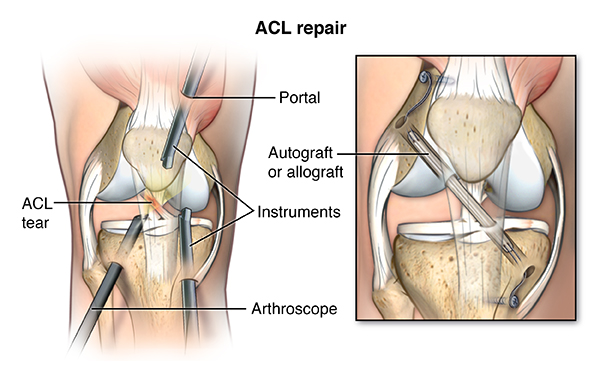Ligaments are bands of tough, elastic connective tissue that surround a joint to give support and limit the joint's movement.
When ligaments are damaged, the knee joint may become unstable. Ligament damage often happens from a sports injury. A torn ligament severely limits knee movement. This results in the inability to pivot, turn, or twist the leg. Surgery is a choice to repair a torn ligament if other medical treatment is not effective.
There are 4 major ligaments in the knee. The ligaments in the knee connect the femur (thighbone) to the tibia (shin bone), and include the following:

The anterior cruciate ligament (ACL) is located toward the front of the knee. It is the most common ligament to be injured. The ACL is often stretched and/or torn during a sudden twisting motion (when the feet stay planted one way, but the knees turn the other way). Skiing, basketball, and football are sports that have a higher risk of ACL injuries.
The posterior cruciate ligament (PCL) is located toward the back of the knee. It is also a common knee ligament to be injured. However, the PCL injury usually happens with sudden, direct impact, such as in a car accident or during a football tackle.
The medial collateral ligament (MCL) is located on the inner side of the knee. It is injured more often than the lateral collateral ligament (LCL), which is on the outer side of the knee. Stretch and tear injuries to the collateral ligaments are usually caused by a blow to the outer side of the knee, such as when playing hockey or football.
A knee ligament tear may be treated with the following:
Knee ligament repair is a treatment for a complete tear of a knee ligament that results in instability in the knee. People with a torn knee ligament may be unable to do normal activities that involve twisting or turning at the knee. The knee may buckle or “give-way.” If medical treatments are not satisfactory, ligament repair surgery may be an effective treatment
The surgery to correct a torn knee ligament involves replacing the ligament with a piece of healthy tendon. A tendon from the kneecap or hamstring, for example, is grafted into place to hold the knee joint together. The tendon graft may come from the person (autograft) or from an organ donor (allograft).
There may be other reasons for your healthcare provider to recommend a knee ligament repair.
As with any surgical procedure, complications can happen. Some possible complications may include the following:
Some people may experience pain, limited range of motion in the knee joint, and occasional swelling in the knee after surgical ligament repair. Others have increased motion in the knee joint as the graft stretches over time.
There may be other risks depending on your specific medical condition. Be sure to discuss any concerns with your healthcare provider before the procedure.
Knee ligament repair may be performed on an outpatient basis or rarely as part of your stay in a hospital. Procedures may vary depending on your condition and your healthcare provider’s practices.
Knee ligament repair may be performed while you are asleep under general anesthesia, or while you are awake under spinal anesthesia. If spinal anesthesia is used, you will have no feeling from your waist down. Your healthcare provider will discuss this with you in advance.

Generally, knee ligament repair surgery follows this process:
After the surgery you will be taken to the recovery room for observation. Your recovery process will vary depending on the type of anesthesia that is given. Once your blood pressure, pulse, and breathing are stable and you are alert, you will be taken to your hospital room or discharged to your home. Knee ligament repair is usually done on an outpatient basis.
You may be given crutches and a knee immobilizer before you go home.
Once you are home, it is important to keep the surgical area clean and dry. Your healthcare provider will give you specific bathing instructions. The stitches or surgical staples will be removed during a follow-up office visit.
Take a pain reliever for soreness as recommended by your healthcare provider. Aspirin or certain other pain medicines may increase the chance of bleeding. Be sure to take only recommended medicines.
To help reduce swelling, you may be asked to elevate your leg and apply an ice bag to the knee several times per day for the first few days. Your healthcare provider will arrange for an exercise program to help you regain muscle strength, stability, and range of motion.
Notify your healthcare provider to report any of the following:
You may resume your normal diet unless your healthcare provider advises you differently.
Because of the limited mobility, it may be difficult for a few weeks to resume your normal daily activities. You may need someone at home to assist you. You should not drive until your healthcare provider tells you to. Other activity restrictions may apply. Full recovery from the surgery and rehabilitation may take several months.
Your healthcare provider may give you additional or alternate instructions after the procedure, depending on your particular situation.

5000

1000

10000

750